
Station Name: DOVER MARINE/DOVER WESTERN DOCKS[Source:
Nick Catford]
old6.jpg) In 1911 Work is underway to reclaim sufficient from the harbour before construction of the new station can start. This involved creating a sea wall of concrete blocks to the east of the Admiralty Pier. Huge quantities of chalk were then dumped into the water between the wall and the pier. The former LC&DR line to the Admiralty Pier is seen in the foreground. In the distance two lighthouses are seen on the left, the closer is on the Prince of Wales pierhead; the more distant lighthouse
is on the Southern Breakwater. Copyright photo from John Alsop collection 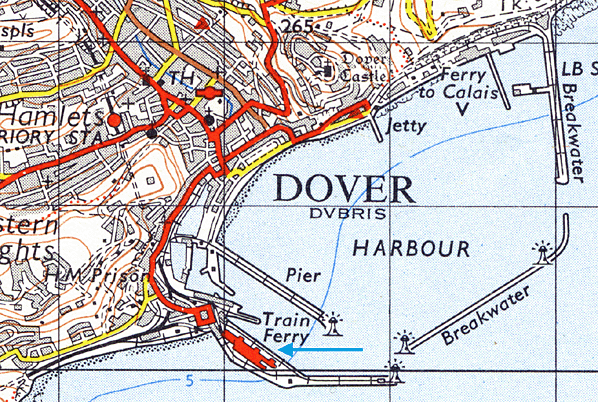 
Track layout around Dover Marine during WW2. Note the military platform to the north-east of the loc shed, this is a remnant of the former Dover Town station platform. Click here for larger version.
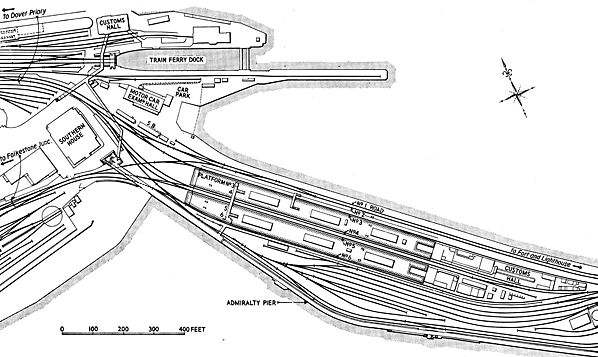
Plan of Dover Marine station in 1959 before the platforms were extended prior to electrification.
Click here for a larger version. marine_old14.jpg) Dover Marine station during construction in October 1911. The land for the station was reclaimed from the sea and was created by dumping large quantities of chalk into the water and then driving 1,200 ferro-concrete piles through the chalk into the seabed below. The piles which were up to 75 feet long and seventeen inches in diameter were manufactured on site as seen in this view. Driving in the piles was completed in 1912.
marine_old22.jpg)
Dover Marine station under construction looking north c1913. The metal framework of the trainshed has been completed. The platforms have been built and some platform buildings are seen. The west side wall of the trainshed is partially built. Click here for Dover Marine Station Gallery 2:
10 November 1920 - c1950s marine_old65.jpg) On 10 November 1920, the coffin holding the body of the Unknown Warrior was taken to Boulogne where HMS Verdun lay waiting to bring him home to Britain. As HMS Verdun approached Dover, the Prince of Wales Pier was overflowing with people who had come to pay their respects. The town’s shops had closed, and flags were flown at half mast. Six bearers, Lieutenant-Colonels or the equivalent rank from all of the armed forces, boarded the ship, and the coffin was received by General Sir J. Longley, Commander of the Eastern Area, and Colonel Knight, Commander of the Dover Garrison. The party processed to the western platform of the Marine station, from which the train to London was due to leave at 5.50pm. A plaque now commemorates the Unknown Warrior’s home-coming. The coffin was placed in passenger luggage van No.132 of the South Eastern and Chatham Railway Company, the same van which had carried the bodies of Nurse Edith Cavell and Captain Charles Fryatt. From Dover Marine station the Unknown Warrior was to London for burial the following day at Westminster Abbey.
On 10 November 1920, the coffin holding the body of the Unknown Warrior was taken to Boulogne where HMS Verdun lay waiting to bring him home to Britain. As HMS Verdun approached Dover, the Prince of Wales Pier was overflowing with people who had come to pay their respects. The town’s shops had closed, and flags were flown at half mast. Six bearers, Lieutenant-Colonels or the equivalent rank from all of the armed forces, boarded the ship, and the coffin was received by General Sir J. Longley, Commander of the Eastern Area, and Colonel Knight, Commander of the Dover Garrison. The party processed to the western platform of the Marine station, from which the train to London was due to leave at 5.50pm. A plaque now commemorates the Unknown Warrior’s home-coming. The coffin was placed in passenger luggage van No.132 of the South Eastern and Chatham Railway Company, the same van which had carried the bodies of Nurse Edith Cavell and Captain Charles Fryatt. From Dover Marine station the Unknown Warrior was to London for burial the following day at Westminster Abbey.marine_old15.jpg)
Dover Marine station looking north from platform 5 in 1921 two years after the station opened to the public. There were two 60-foot wide island platforms numbered 3 and 4 and 5 and 6. Roads 1 and 2 did not serve platform faces and were outside the trainshed and were used by trains loading goods directly onto ships.
Photo from Jim Lake collection marine_old36.jpg) The only locomotive facilities at Dover Marine were a turntable and water tank behind the signal box; they are seen in this view from the 1920s. Locomotives were allocated to the former LC &DR shed at Dover Priory. This was replaced by a new 5-road shed on the site of Dover Town station in 1928. The turntable and tank seen here were removed at this time.
Photo from John Mann collection old7.jpg)
Dover
Marine station seen from the Lord Warden hotel before August 1923. The covered footbridge from the pedestrian entrance is seen on the right passing over the lines to the Admiralty Pier. The width of the two island platforms is clearly seen in this view
Copyright photo from John Alsop collection old9.jpg)
Looking south towards Dover Marine station in May 1925. The pedestrian entrance opposite the Lord Warden Hotel is seen on the right. From there a 455-foot long enclosed glazed footbridge too passengers into the station. Dover Marine's 120-kever signal box is seen on the left.
Copyright photo John Alsop collection old10.jpg)
The rail entrance to platform 3 at Dover Marine station in 1928. The ship berth, served by two railway tracks is seen on the left. 'Lord Nelson' class 853 is seen. This loco entered SR service in September 1928 and was named Sir Richard Grenville after the famous Royal Navy Admiral. Built at Eastleigh works to a design by Richard Maunsell and fitted with smoke deflectors in the late 1920s, it also benefitted from modifications by Bulleid when he took over from Maunsell as Chief Mechanical Engineer in 1938. Renumbered to 30853 by BR in 1948, it was withdrawn from 71B, Bournemouth shed on 3 March 1962 and scrapped very soon afterwards
Copyright photo John Alsop collection marine_old15.jpg) The 11am boat train from London Victoria is seen passing Dover Town station on the approach to Dover Marine on 16 June 1924. This train is the predecessor of the 'Golden Arrow'. 497 was built at Ashford Works to a Harry Wainwright E Class design entered service in September of 1907. This loco was rebuilt in the early 1920s by Maunsell with a larger boiler, firebox and cylinders and renumbered by the Southern Railway to 1497. It was finally withdrawn by BR from 73B, Bricklayers Arms shed numbered 31497 on 22 October 1960 and broken up later that year. It was involved in a crash on 5 March 1909 when it overran signals at Tonbridge Junction, Kent whilst hauling an express passenger working and loco 165 that was hauling a mail train, ran into it killing two and injuring eleven.
Photo from John Mann collection 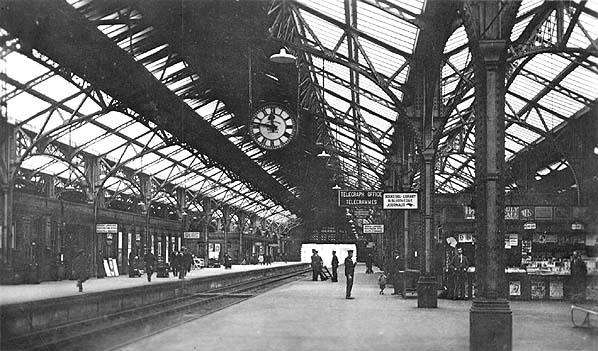
marine_old40.jpg)
The approach to Dover Marine station c1933 during the construction of the train ferry dock. Initially a sheet metal cofferdam with an earth embankment was constructed but this was washed away during the winter of 1933/4 after which 10-ton concrete blocks were laid on foundations on the seabed.
Photo from Jim Lake collection marine_old20.jpg)
Looking north towards Dover Marine station from the Admiralty Pier c 1930s. The Dover Turret is seen on the left. This fort, at the the ten end of the Admiralty Pier, was completed in 1880 and mounted with two 16in, 81-ton rifled muzzle loading (RML) guns with a range of 4.3 miles. The Grand Shaft barracks on top of the Western Heights, is seen in the background.
old5.jpg) During WW2 the Marine station was prone to consistent shelling and was closed after the Dunkirk evacuation. On 7 June 1944 Southern’ Railway's engine shed near Marine Station received a direct hit seriously injuring Henry Whitewood, who died a week later. The worst damage to the Marine station occurred overnight on 12 September 1944, luckily most of the damage was confined to the roof. Note the lack of any kind of signage. By this time All trains and stations, by this time,Dover subject to the blackout. Station names were removed so passengers had to rely on a porter shouting out the name. At night, as most station lights were sprayed with blue paint, platforms were sparsely lit and even that was extinguished when the air raid warning was sounded. During WW2 the Marine station was prone to consistent shelling and was closed after the Dunkirk evacuation. On 7 June 1944 Southern’ Railway's engine shed near Marine Station received a direct hit seriously injuring Henry Whitewood, who died a week later. The worst damage to the Marine station occurred overnight on 12 September 1944, luckily most of the damage was confined to the roof. Note the lack of any kind of signage. By this time All trains and stations, by this time,Dover subject to the blackout. Station names were removed so passengers had to rely on a porter shouting out the name. At night, as most station lights were sprayed with blue paint, platforms were sparsely lit and even that was extinguished when the air raid warning was sounded.marine_old34.jpg)
The north end of the Dover Marine trainshed in August 1947. The photographer is standing beneath the long footbridge that links the passenger entrance opposite the Lord Warden hotel with the train ferry dock. In the distance the Prince of Wales pierhead is seen and beyond that the Southern Breakwater.
Photo from John Mann collection
marine_old65.jpg)
Storm damage at Dover Marine circa mid 1950s; the carriage shed is seen in the background. The Admiralty Pier has always suffered during bad weather. When the pier was under construction, on 8 October 1850 an intense storm, centred on Dover, destroyed much of the works. Piles, 18in square, were snapped and three huge diving bells were carried away to sea. At daybreak the bay was strewn with fragments of timber and machinery including broken cranes, air-pumps and traversers.
marine_old27.jpg)
Dover Marine station in early 1959 during construction work to extend the platforms by 114 feet prior to electrification London (via Faversham) line in June that year. During the work stat station was closed for a week at the end of February, reopening in 1 March 1959. The work also involved some changes to the track to accommodate the platform extensions.
old1.jpg) Battle of Britain
4-6-2 No. 34071 '601 Squadron' at Dover Marine station in February 1960. This view shows the prefabricated concrete extensions to the platforms and the plain W shaped canopy. 601 Squadron was designed by Bullied and built at Eastleigh works in October 1945. Three months after this photo was taken, 34071 was rebuilt at Eastleigh and stayed at Eastleigh shed until withdrawal after just 19 years of service on 30 April 1967 to be cut up at Cashmores of Newport five months later.
Copyright photo by Alan Lewis Chambers from his Railway Images web site marine_old18.jpg)
Dover Marine station in 1960. The passenger entrance can just be made out top left, opposite the Lord Warden hotel. From that, two footbridges are seen. one runs along the east side of the hotel to the train ferry dock which is seen to the right of the hotel. The other is in line with the Admiralty Pier and then turns sharply to the east to enter the Marine station near the north end of the trainshed. This then joined up with an internal footbridge spanning the platforms. On the west side of the trainshed the curving four-road carriage shed is seen. The original pierhead with the gun turret is seen bottom left. The pier was widened here and extended in the first decade of the 20th century. Click here for a larger version.
marine_old26.jpg)
Working the 'Golden Arrow' out of Dover Marine circa early 1960s is 70004, 'William Shakespeare, a Riddles designed Britannia Pacific. Delivered new to 30A, Stratford shed on 29 March 1951, it was polished up and given a special finish to appear with the new Golden Arrow Pullmans at the Festival of Britain Exhibition between May and September of that year. Transferring to 73A, Stewarts Lane Shed in the October, it became well travelled in the 60s with Trafford Park, Willesden, Aston, Crewe North and Stockport sheds to it’s name, finally being withdrawn on 30 December 1967 from 12A, Carlisle Kingmoor and cut up during March the following year by T.W.Ward of Iverkeithing.
Photo from Jim Lake collection marine_old66.jpg)
Passengers boarding the Golden Arrow at Dover Marine station circa early 1960s.
marine_old33.jpg) The approach to Dover Marine station from the Folkestone direction in the Early 1960s. The platform extensions are clearly seen with their plain W shaped canopies. The footbridge to the pedestrian entrance opposite the Lord Warden hotel is seen in the foreground.
Photo from John Mann collection marine_old29.jpg)
Platforms 4 (left) and 5 at Dover Marine station seen from the footbridge in the 1960s.
Photo from John Mann collection
marine_old25.jpg)
The 'Golden Arrow; is seen approaching Dover Marine station in the 1960s. In 1961, with the Kent Coast electrification scheme, the service became electric-hauled. This allowed an acceleration to 80 minutes for the down service and 82 minutes for the up service. Twenty-four electric locomotives were built in 1958 for the Kent Coast main lines. They were built at the British Rail workshops in Doncaster. Class 71 E5015 is seen here passing under the passenger footbridge before entering the station.
Photo from Jim Lake collection marine_old39.jpg)
The 'Night Ferry' is awaiting departure from Dover Marine to London Victoria in the 1960s. When the train arrived at Dunkirk the it was split into sections and loaded equally on tracks on the port and starboard sides of the ship, to maintain its balance. The coaches were chained to four parallel lines on the deck. Each overnight train carried up to five (very occasionally six) sleeping cars plus baggage cars. On arrival at Dover, the coaches were shunted to the Marine station where a waiting class 73 electro-diesel was ready for the final leg of the journey to Victoria. In the old days, the 'Night Ferry' was was the only service of the Southern Railway to be regularly double-headed, with a Bulleid Pacific and E1 or L class 4-4-0 locomotives. The train was not a good timekeeper because of the complexity of loading
and offloading coaches Photo from John Mann collection docks21.jpg)
A class 71 is seen at Dover Marine station in June 1969. This class of locos 2700 power was useful for heavy freight and express passenger work. Acceleration on passenger trains (even when heavily loaded) was quite astonishing - to the extent the climb out of London Victoria was almost unnoticeable . Prestigious services including the 'Night Ferry' (London to Paris overnight by train-ferry) and the 'Golden Arrow', were a mainstay of the class for many years.
Photo by Terry Tracey marine_old64.jpg) Looking north from the road to the train ferry dock in June 1869. Dover Marine station is behind the photographer. The clock tower of the closed Dover Harbour station is seen in the distance.
Photo by Terry Tracey
marine59.jpg)
The street level passenger entrance opposite the Lord Warden Hotel in September 1973. There is a wide stairway up to the footbridge inside the building, both the stairway and the footbridge are divided down the centre with cast iron railings. The sign above the door on the left says 'Dover Marine - Trains and Ships' while that on the right says 'Promenade and fishing only'. The footbridge on the left runs to the train ferry dock. The 120-lever Marine signal box is seen below the bridge.
Photo by John Mann marine62.jpg)
Dover Marine station in September 1973. The ferry dock footbridge has suffered badly from the bad weather and has been strengthened. With the withdrawal of the 'Night Ferry' on 31 October 1980 the dock's days were numbered and it finally closed 8 May 1987. This bridge was quickly demolished.
Photo by John Mann marine_old69.jpg) Looking north along platform 5 at Dover Marine station on 31 July 1976 during a visit by the Lea Valley Railway Club's 'Sunny South Express' railtour. The tour was a round trip from Charing Cross with DEMU 1034. A number of closed passenger lines were visited including Tilmanstone Colliery on the East Kent Light Railway and Ardingly on the electrified link to the Bluebell line and Lavant.
Photo by Alan Young docks35.jpg)
The 4-roqad carriage shed at Dover Marine station in January 1978. Two 4-CEP units are seen in the shed with a class 33 alongside. The Admiralty Pier is seen curving round on the right. Before Dover Marine opened the two original platforms at Admiralty Pier were beneath the promenade. The roof of the customs hall is seen in the background.
Photo
by John Law from his Flickr photostream
docks_emr14.jpg)
Night Ferry Type
F sleeping car in the traditional colours of the CIWL (Compagnie Internationale
des Wagons-Lits) just having arrived at Platform 4 at Dover Western
Docks in the late 1970's. Type F sleeping cars have passenger access doors at one end only. The door space at this end contains an attendant's office and opposite is a compartment for a boiler.
Copyright photo from Eastbank Model Railway Club web site marine47.jpg)
Class 410 (4-BEP) 7005 stands at platform 5 at Dover Western Docks station in 1982. British Rail Class 411 electrical multiple units were built at Eastleigh works from 1956-63 for the newly electrified main lines in Kent. A variant of the class 411 design was the class 410 which contained a buffet car in place of a standard trailer.
marine48.jpg) The Orient Express hauled by a class 73 and diverted from Folkestone Harbour is seen at Dover Western Docks station in 1982. The Venice Simplon-Orient-Express, or VSOE, is a private luxury train service from London to Venice and other European cities. The VSOE has separate carriages for use in the UK and for continental Europe, but all of the same vintage (mostly dating from the 1920s and 1930s). Restored Pullman carriages are used in the UK and over the channel restored dark blue former Compagnie Internationale des Wagons-Lits carriages are used. These days, passengers are conveyed across the English Channel by coach through the Channel Tunnel.
Photo by John Law from his Flickr photostream marine_old76.jpg)
21 September 1985 saw the Metropolitan Railway electric locomotive No. 12 'Sarah Siddons' work the London Regional Transport/British Rail 'Romney, Hythe & Dymchurch Railtour' around Kent. The train started at Victoria and ran via Swanley and Tonbridge to Folkestone West, from where passengers were taken for a trip on the Romney Hythe and Dymchurch Railway. The tour restarted from Dover Western Docks and ran via Faversham and Eltham to London Bridge. 'Sarah Siddons; is seen
at Dover Western Docks. Photo by Richard Allen from his Flickr photostream docks67.jpg)
4-CEP EMU set 1583 departs Dover Western Docks leading service 1P46 the 13.47 Dover Western Docks to London Victoria in August 1987. On the right stands immaculate 47 621 then named 'Royal County of Berkshire' waiting departure with 1M04 the 13.55 to Liverpool Lime Street. The vessel on the left moored alongside the quay was the RMT 'Jetfoil lounge' a floating pontoon vessel where passengers waited before joining the Jetfoil service to Ostend in Belgium.
Photo by Adrian Nichols from his Flickr photostream docks68.jpg)
47527 passes Dover Ferry sidings with 1M04 13.55 Dover Western Docks to Liverpool Lime Street
on 20 April 1988. Photo by Graham Walker from his Flickr photostream marine_old75.jpg)
Four months later everything had changed, this the the Dover Ferry Dock (seen in the picture above) in August 1988 after the track was lifted. The dock It was taken out of use in 1987-88 when the new train ferry built for SNCF the 'Nord Pas-de-Calais' was introduced to the Dover to Dunkerque route. Being a much larger vessel it used a new link span located beyond Dover Western Docks station beside the southern breakwater.
Photo by Adrian Nichols from his Flickr photostream 12.jpg) The old train
ferry terminal and customs shed at Dover Western Docks in
August 1988.
Photo by Phil Mackie weste_docks37.jpg) By August 1993 the station's days were numbered; a year later it would close. Network Southeast 4-CEP unit No. 1520 departs Dover Western Docks at the rear of the 14,35 Boat Train to Victoria Photo
by Brian Creasey
weste_docks38.jpg)
Network Southeast 4-CEP units Nos. 1566 and 1581 stand at Dover Western Docks on in August 1993.
Photo by Brian Creasey weste_docks40.jpg)
Network Southeast 4-VEP unit No. 3184 departs Dover Western Docks working a stopping service to Victoria via Chatham on the 21st August 1994, a month before closure
Photo by Brian Creasey marine_old71.jpg) The 'Continental Farewell' railtour from London Victoria is seen at Dover Western Docks station on 25 September 1994. This tour featured ex-BR Pacific 70000 'Britannia' (but presented on this occasion as 70014 'Iron Duke' which was one of two Britannia class locomotives regularly used on the 'Golden Arrow' service in the 1950s). This was the last day of use at Western Docks, the station having closed to regular passengers the previous day. There were also 2 mini-tours (The Kentish Wanderer A and B) with HA E5000 series E5001 (seen left) that ran with the stock off the main tour. It ran via Canterbury West, Ashford and Folkestone.
Photo by Andy Veitch from his Flickr photostream marine_old73.jpg)
As the evening draws in on 25 September 1994 the railtour prepares from the return journey to Victoria.
Photo
by Andy Veitch from his Flickr photostream
1.jpg)
Dover
Western Docks Station in January 1995, 3 months after closure. After 'official' closure the station continued to be used by unadvertised passenger trains to Faversham until 19 November 1994 after which date they were classified as empty stock movements. In January 1995 the
station was still being used for train berthing and cleaning.
Photo by Nick Catford 3.jpg)
Dover Western Docks entrance in January 1995, the sign above the door has been removed but the door is still open.
Photo by Nick Catford 4.jpg) Looking north towards Dover Docks station from the Admiralty Pier in March 1896. Everything south of the trainshed has been cleared awaiting redevelopment.
Photo by Nick Catford 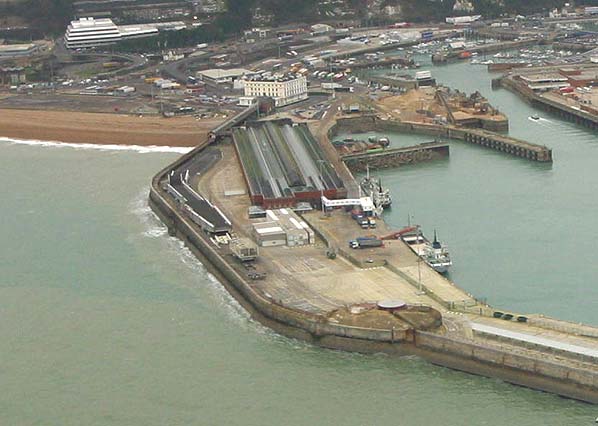
Dover Western
Docks station in January 2003. The listed station reopened as a cruise
terminal in 1996.
Photo by Chris Fletcher docks19.jpg) The cruise terminal and Dover Western Docks in 2005.
docks22.jpg)
Dover Western
Docks station in 2006, the track bed has been filled up to platform level to create a car park. Apart from this and the lack of signage little else has changed since closure. The four K6 red telephone boxes (two on the platform and two outside the trainshed at the south-west corner)
are also listed. Photo Ted Arnott docks24.jpg)
docks31.jpg)
Dover Western Docks station platform 4 in June 2012. The war memorial is seen on the end of the building, This shows the names of the 356 men of the South Eastern and Chatham Railway who died in the First World War and the 626 men of the Southern Railway who died in the Second World War.
Photo from Nick Catford collection marine49.jpg) Dover Western Docks station seen from a cruise liner moored alongside in June 2012.
Photo from Nick Catford collection
Click on thumbnail to enlarge
Click here for more pictures of Dover Marine/Dover Western Docks Station
|
 Dover Harbour, which is generally acknowledged to be one of the greatest feats of port construction at that time, was completed in 1909. The walls and piers were built of large blocks weighing from 30 to 40 tons. These blocks were made of concrete, with a granite facing to those that were to be placed on the outside surfaces of the walls above water level. The completed harbour was opened on 14 October 1909 by H.R.H. the Prince of Wales, the future King George V. In 1909 work started on the new station to create an artificial platform for the new terminus alongside the north end of the Admiralty Pier.
Dover Harbour, which is generally acknowledged to be one of the greatest feats of port construction at that time, was completed in 1909. The walls and piers were built of large blocks weighing from 30 to 40 tons. These blocks were made of concrete, with a granite facing to those that were to be placed on the outside surfaces of the walls above water level. The completed harbour was opened on 14 October 1909 by H.R.H. the Prince of Wales, the future King George V. In 1909 work started on the new station to create an artificial platform for the new terminus alongside the north end of the Admiralty Pier.
 Repatriated British prisoners of war started to arrive at Dover on 17 November 1918. By February 1919 180 boats conveying 55,398 released former POW’s were received by 130 trains. In January 1919 the large Customs Examination Shed in the station was utilised for the sorting out of demobilised men, who began to arrive at Dover in large numbers. The numbers passing through Dover amounted to 720,664 service men. When the armistice came in November 1918, the SE&CR had a fine record of war service to its credit, and Field Marshall Sir Douglas Haig wrote the following letter of commendation to Cosmo Bonsor, the Chairman of the SE&CR Managing Committee; ‘The Army in France owes much to all connected with the control of our railway companies in the United Kingdom, and indeed in the Empire. They have at all times shown great willingness to help us in every possible way in their power. Track has been torn up to give us rails, engines, trucks, men, capable engineers, operations staff all have been sent abroad to us, regardless of their own special needs and demands of the people at home, and without a moment’s hesitation. But we have been more closely associated with the South Eastern and Chatham Railway than any other. The bulk of our ammunition and stores required for the maintenance of our armies, as well as several millions of men as reinforcements and on leave, have passed over their system. Their sphere of duty, too, has been nearest to the shores of France and Belgium, and consequently more open to hostile attacks by air and fear of invasion by sea. Undisturbed by any alarms the traffic for the Armies in France has never ceased to flow. This reflects the greatest credit on all concerned with the company’.
Repatriated British prisoners of war started to arrive at Dover on 17 November 1918. By February 1919 180 boats conveying 55,398 released former POW’s were received by 130 trains. In January 1919 the large Customs Examination Shed in the station was utilised for the sorting out of demobilised men, who began to arrive at Dover in large numbers. The numbers passing through Dover amounted to 720,664 service men. When the armistice came in November 1918, the SE&CR had a fine record of war service to its credit, and Field Marshall Sir Douglas Haig wrote the following letter of commendation to Cosmo Bonsor, the Chairman of the SE&CR Managing Committee; ‘The Army in France owes much to all connected with the control of our railway companies in the United Kingdom, and indeed in the Empire. They have at all times shown great willingness to help us in every possible way in their power. Track has been torn up to give us rails, engines, trucks, men, capable engineers, operations staff all have been sent abroad to us, regardless of their own special needs and demands of the people at home, and without a moment’s hesitation. But we have been more closely associated with the South Eastern and Chatham Railway than any other. The bulk of our ammunition and stores required for the maintenance of our armies, as well as several millions of men as reinforcements and on leave, have passed over their system. Their sphere of duty, too, has been nearest to the shores of France and Belgium, and consequently more open to hostile attacks by air and fear of invasion by sea. Undisturbed by any alarms the traffic for the Armies in France has never ceased to flow. This reflects the greatest credit on all concerned with the company’.  Much of the north end of Admiralty Pier was incorporated into an extensive network of trackwork and sidings around the new station; these were required to handle the large quantity of freight traffic passing through Dover during the war. Access to the station and sidings was controlled by a large 120-lever SE&CR designed signal box on the down side approach to the station. The two platforms were spanned by a lattice footbridge at the north end of the trainshed.
Much of the north end of Admiralty Pier was incorporated into an extensive network of trackwork and sidings around the new station; these were required to handle the large quantity of freight traffic passing through Dover during the war. Access to the station and sidings was controlled by a large 120-lever SE&CR designed signal box on the down side approach to the station. The two platforms were spanned by a lattice footbridge at the north end of the trainshed. 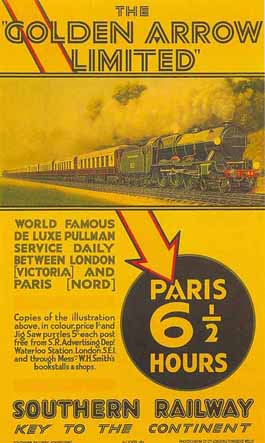 On each platform there were three large blocks of brick buildings, each 100 ft in length and 25 ft in width. These buildings were allocated to a variety of purposes, including waiting rooms, tea rooms, dining and refreshment facilities, post and parcel shed railway staff rooms etc. At the end of each platform nearest to the Admiralty Pier provision was made for a Post Office, and at the end of the other platform there was a Customs Examination and Clearance Shed.
On each platform there were three large blocks of brick buildings, each 100 ft in length and 25 ft in width. These buildings were allocated to a variety of purposes, including waiting rooms, tea rooms, dining and refreshment facilities, post and parcel shed railway staff rooms etc. At the end of each platform nearest to the Admiralty Pier provision was made for a Post Office, and at the end of the other platform there was a Customs Examination and Clearance Shed.  On 14 November 1924 the 'Continental Express' boat train was introduced and consisted of the six first class Pullman cars, a baggage and brake van. It left London Victoria at 10.50 am, the return 'Continental Express' train leaving Dover for London at 5.30 pm.
On 14 November 1924 the 'Continental Express' boat train was introduced and consisted of the six first class Pullman cars, a baggage and brake van. It left London Victoria at 10.50 am, the return 'Continental Express' train leaving Dover for London at 5.30 pm.
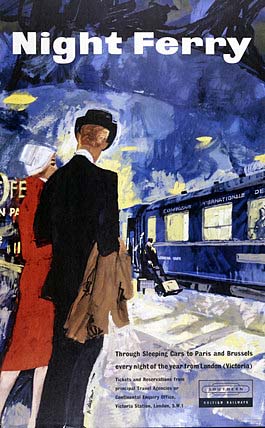 The Canterbury was launched on 13 December 1928 at Dumbarton and arrived in Dover on 30 April 1929 and commenced service on 15 May, the same day as the ‘Golden Arrow’. The journey between London and Paris was advertised to take 6½ hours and each day the ‘Golden Arrow’ was scheduled to depart London Victoria at 11.00hrs and reach Dover Marine station at 12.38hrs. As the line is fairly level with a very long straight section, speeds of 60 mph were not unknown. Having crossed the Channel in the Canterbury and on reaching Calais the passengers were transferred to the awaiting ‘Fléche d’Or’, a four-cylinder Nord Pacific of the French Northern railway, arriving in Paris at 5.35pm UK time. The single fare was £6.10s.
The Canterbury was launched on 13 December 1928 at Dumbarton and arrived in Dover on 30 April 1929 and commenced service on 15 May, the same day as the ‘Golden Arrow’. The journey between London and Paris was advertised to take 6½ hours and each day the ‘Golden Arrow’ was scheduled to depart London Victoria at 11.00hrs and reach Dover Marine station at 12.38hrs. As the line is fairly level with a very long straight section, speeds of 60 mph were not unknown. Having crossed the Channel in the Canterbury and on reaching Calais the passengers were transferred to the awaiting ‘Fléche d’Or’, a four-cylinder Nord Pacific of the French Northern railway, arriving in Paris at 5.35pm UK time. The single fare was £6.10s. The specifications, drawn up by George Elson, Chief Engineer of Southern Railway, was a concrete dock 414-feet long and 72-feet wide, with a minimum depth of water of 17-feet to a maximum of 36-feet. Construction work started in August 1933 and two railway lines were laid to connect the dock to the main line into Dover Marine. The Southern Railway commissioned three purpose built ferries from Swan, Hunter & Wigham Richardson of Newcastle-on-Tyne. Each ship was designed to take 12 sleeping cars, 500 passengers during the day, or approximately 40 goods wagons. There was also a small floor above the train deck to accommodate approximately 20 cars.
The specifications, drawn up by George Elson, Chief Engineer of Southern Railway, was a concrete dock 414-feet long and 72-feet wide, with a minimum depth of water of 17-feet to a maximum of 36-feet. Construction work started in August 1933 and two railway lines were laid to connect the dock to the main line into Dover Marine. The Southern Railway commissioned three purpose built ferries from Swan, Hunter & Wigham Richardson of Newcastle-on-Tyne. Each ship was designed to take 12 sleeping cars, 500 passengers during the day, or approximately 40 goods wagons. There was also a small floor above the train deck to accommodate approximately 20 cars. On 14 January 1939 Neville Chamberlain together with Lord Halifax, foreign secretary, travelled by way of Dover Marine, using the ‘Golden Arrow’ and the ‘Canterbury’, for Rome. This was to meet with Benito Mussolini, Italian prime minister and leader of the National Fascist Party, in an effort to persuade him not to become involved in the pending conflict. World War II was declared on 3 September 1939. Following the ‘Golden Arrow’s’ last trip, the ‘Canterbury’ left Dover for conversion into a troop carrying ship. The ship ‘Invicta’ was built in 1939 to take over from the ‘Canterbury’ but she was also commandeered for war work following her launch in 1940.
On 14 January 1939 Neville Chamberlain together with Lord Halifax, foreign secretary, travelled by way of Dover Marine, using the ‘Golden Arrow’ and the ‘Canterbury’, for Rome. This was to meet with Benito Mussolini, Italian prime minister and leader of the National Fascist Party, in an effort to persuade him not to become involved in the pending conflict. World War II was declared on 3 September 1939. Following the ‘Golden Arrow’s’ last trip, the ‘Canterbury’ left Dover for conversion into a troop carrying ship. The ship ‘Invicta’ was built in 1939 to take over from the ‘Canterbury’ but she was also commandeered for war work following her launch in 1940. 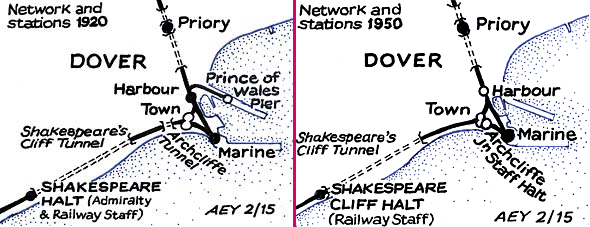
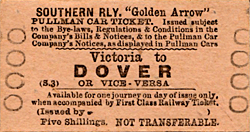 To accommodate 12-car multiple-unit trains when the electrification from London via, Faversham started in June 1959, the two island platforms at Dover Marine were extended by 114 feet, with 24-foot ramps. The extensions comprised prefabricated concrete components, manufactured at Exmouth Junction concrete works. This necessitated altering the layout of the tracks at the London end and the construction of a riveted steel footbridge across the approach tracks from Dover Priory, linking the main entrance beside the Lord Warden Hotel with the Customs Hall, on the northern perimeter of the Western Docks. The bridge ran from the landing at the top of the stairs from the street entrance opposite the Lord Warden hotel.
To accommodate 12-car multiple-unit trains when the electrification from London via, Faversham started in June 1959, the two island platforms at Dover Marine were extended by 114 feet, with 24-foot ramps. The extensions comprised prefabricated concrete components, manufactured at Exmouth Junction concrete works. This necessitated altering the layout of the tracks at the London end and the construction of a riveted steel footbridge across the approach tracks from Dover Priory, linking the main entrance beside the Lord Warden Hotel with the Customs Hall, on the northern perimeter of the Western Docks. The bridge ran from the landing at the top of the stairs from the street entrance opposite the Lord Warden hotel. 
 Dover Marine was renamed Dover Western Docks on 14 May 1979 and although its future seemed secure the ‘Night Ferry’ was withdrawn on 31 October 1980. By this time the carriages were dated and in need of replacement; they were not air conditioned, and during the ship voyage, while inside the ship, they became notably hot in summertime. This was exacerbated by the chaining of the vehicles to the ship's deck, an activity underneath the sleeping compartments which inevitably woke most passengers up during the middle of the night. The carriages were over 40 years old, and by some margin were the oldest passenger vehicles running on the British network.
Dover Marine was renamed Dover Western Docks on 14 May 1979 and although its future seemed secure the ‘Night Ferry’ was withdrawn on 31 October 1980. By this time the carriages were dated and in need of replacement; they were not air conditioned, and during the ship voyage, while inside the ship, they became notably hot in summertime. This was exacerbated by the chaining of the vehicles to the ship's deck, an activity underneath the sleeping compartments which inevitably woke most passengers up during the middle of the night. The carriages were over 40 years old, and by some margin were the oldest passenger vehicles running on the British network. 
 Demolition and track lifting began at the beginning of 1996. The Dover Harbour Board had hoped to demolish everything to build a new cruise terminal but the trainshed and the entrance building on Lord Warden Square were Grade II listed by English Heritage on 22 June 1989 so the only demolition related to the platform extensions that had been added in 1959.
Demolition and track lifting began at the beginning of 1996. The Dover Harbour Board had hoped to demolish everything to build a new cruise terminal but the trainshed and the entrance building on Lord Warden Square were Grade II listed by English Heritage on 22 June 1989 so the only demolition related to the platform extensions that had been added in 1959. 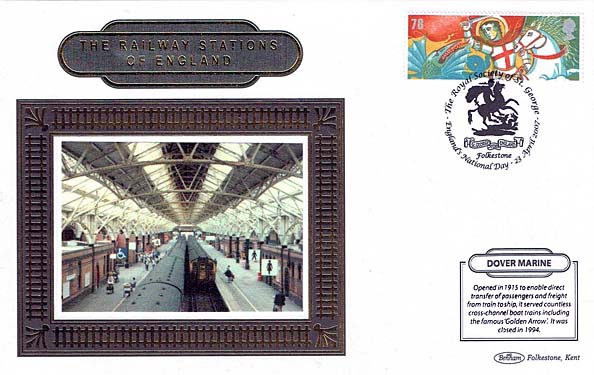
marine_old38.jpg)
marine_old24.jpg)
old12.jpg)
marine_old_thumb67.jpg)
marine_old_thumb17.jpg)
marine_old_thumb37.jpg)
marine_old_thumb21.jpg)
old_thumb2.jpg)
old_thumb3.jpg)
marine_old_thumb23.jpg)
marine_old_thumb28.jpg)
marine_old_thumb30.jpg)
marine_old_thumb31.jpg)
marine_old_thumb32.jpg)
marine_old_thumb41.jpg)
old_thumb11.jpg)
marine_thumb45.jpg)
marine_thumb51.jpg)
marine_thumb52.jpg)
marine_thumb53.jpg)
marine_thumb54.jpg)
marine_thumb55.jpg)
marine_thumb56.jpg)
marine_thumb57.jpg)
marine_thumb58.jpg)
marine_thumb60.jpg)
marine_thumb61.jpg)
marine_thumb63.jpg)
marine_thumb64.jpg)
marine_thumb65.jpg)
marine_thumb66.jpg)
marine_old_thumb70.jpg)
wester_docks_thumb36.jpg)
docks_emr_thumb13.jpg)
docks_emr_thumb15.jpg)
docks_emr_thumb16.jpg)
docks_emr_thumb17.jpg)
docks_emr_thumb77.jpg)
docks_emr_thumb78.jpg)
docks_emr_thumb79.jpg)
docks_emr_thumb80.jpg)
thumb18.jpg)
thumb5.jpg)
thumb6.jpg)
thumb7.jpg)
thumb8.jpg)
thumb9.jpg)
thumb10.jpg)
thumb11.jpg)
weste_docks_thumb39.jpg)
weste_docks_thumb41.jpg)
weste_docks_thumb42.jpg)
weste_docks_thumb43.jpg)
weste_docks_thumb44.jpg)
marine_thumb72.jpg)
_thumb2.jpg)
docks_thumb20.jpg)
docks_thumb23.jpg)
docks_thumb25.jpg)
docks_thumb26.jpg)
docks_thumb27.jpg)
docks_thumb28.jpg)
docks_thumb29.jpg)
docks_thumb30.jpg)
docks_thumb32.jpg)
docks_thumb33.jpg)
docks_thumb34.jpg)
marine_thumb50.jpg)


 Home
Page
Home
Page